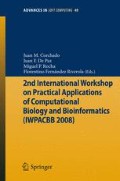Summary
This paper presents algorithms that provide support in the task of reviewing the physiological parameters recorded during a polysomnography, the gold standard test for the diagnosis of Sleep Apnea-Hypopnea Syndrome (SAHS). This support is obtained through the generation of visual metaphors which help identify events (apneas, hypopneas and desaturations) that occur over the span of the recording and are relevant to the diagnosis of SAHS.
The definition of these events is not completely standardized and it is not unusual that different physicians use different criteria when identifying them. To tackle this problem our algorithms start with a linguistic description of the events to be identified. This description is obtained directly from the clinical staff and is projected onto a set of algorithms of a structural nature that support the generation of the visual metaphors. To represent and manipulate the imprecision and vagueness characteristic of medical knowledge we rely on the fuzzy set theory.
The metaphors proposed herein have been implemented in a tool aimed at supporting the diagnosis of SAHS. The tool provides wizards that permit the morphological criteria that define the apneas, hypopneas and desaturations to be customized by the physician and the visual metaphors automatically reflect the new criteria.
Access this chapter
Tax calculation will be finalised at checkout
Purchases are for personal use only
Preview
Unable to display preview. Download preview PDF.
References
Al-Ani, T., Hamam, Y., Fodil, R., Lofaso, F., Isabey, D.: Using hidden Markov models for sleep disordered breathing identification. Simulation modelling 12, 117–128 (2004)
Barro, S., Marín, R., Palacios, F., Ruíz, R.: Fuzzy logic in a patient supervision systems. Artificial Intelligence in Medicine 21, 193–199 (2001)
Beebe, D.W., Gozal, D.: Obstructive sleep apnea and the prefrontal cortex: towards a comprehensive model linking nocturnal upper airway obstruction to daytime cognitive and behavioral deficits. Journal of Sleep Research 11(1), 1–16 (2002)
Cabrero-Canosa, M., Castro-Pereiro, M., Graña Ramos, M., Hernández-Pereira, E., Moret-Bonillo, V., Martin-Egaña, M., Verea, H.: An intelligent system for the detection and interpretation of sleep apneas. Expert Systems with Applications 24, 335–349 (2003)
Kaufmann, A., Gupta, M.M.: Introduction to Fuzzy Arithmetic. Van Nostrand Reinhold Company Inc. (1984)
Köves, P.: Obstructive Sleep Apnea Syndrome. Springer, Heidelberg (1999)
Morsy, A.A., Al-Ashmouny, K.M.: Sleep apnea detection using an adaptive fuzzy logic based screening system. In: 27th IEEE EMB Conference, pp. 6124–6127 (2005)
Nazeran, H., Almas, A., Behbehani, K., Lucas, E.: A fuzzy inference system for detection of obstructive sleep apnea. In: 23th IEEE EMB Conference, pp. 1645–1648 (2001)
American Academy of Sleep Medicine Task Force. Sleep-related breathing disorders in adults: recommendations for syndrome definition and measurement techniques in clinical research. Sleep 22, 667–689 (1999)
Otero, A.: Visual knowledge-based metaphors to support the analysis of polysomnographic recordings, Video (2008), http://biolab.uspceu.com/sahs
Penzel, T., McNames, J., de Chazal, R., Raymond, B., Murray, A., Moody, G.: Systematic comparison of different algorithms for apnea detection based on electrocardiogram recordings. Med. Biol. Eng. Comput 40, 402–407 (2002)
Phillipson, E.A.: Sleep apnea. A major public health problem. N. Engl. J. Med. 328, 1271–1273 (1993)
Ulukavak, T., Kokturk, O., Ozkan, S.: Apnea-Hypopnea Indexes Calculated Using Different Hypopnea Definitions and Their Relation to Major Symptoms. Sleep and Breathing 8(3), 141–146 (2004)
Varaday, P., Micsik, T., Benedeck, S., Benyo, Z.: A nobel method for the detection of apnea and hypopnea events in respiration signals. IEEE Transactions on Biomedical Engineering 49, 936–942 (2002)
Young, T., Palta, M., Dempsey, J., Skatrud, J., Weber, S., Badr, S.: The occurrence of sleep-disordered breathing among middle-aged adults. Med. Biol. Eng. Comput. 328(17), 1230–1235 (1993)
Author information
Authors and Affiliations
Editor information
Rights and permissions
Copyright information
© 2009 Springer-Verlag Berlin Heidelberg
About this paper
Cite this paper
Otero, A., Félix, P., Zamarrón, C. (2009). Visual Knowledge-Based Metaphors to Support the Analysis of Polysomnographic Recordings. In: Corchado, J.M., De Paz, J.F., Rocha, M.P., Fernández Riverola, F. (eds) 2nd International Workshop on Practical Applications of Computational Biology and Bioinformatics (IWPACBB 2008). Advances in Soft Computing, vol 49. Springer, Berlin, Heidelberg. https://doi.org/10.1007/978-3-540-85861-4_2
Download citation
DOI: https://doi.org/10.1007/978-3-540-85861-4_2
Publisher Name: Springer, Berlin, Heidelberg
Print ISBN: 978-3-540-85860-7
Online ISBN: 978-3-540-85861-4
eBook Packages: EngineeringEngineering (R0)

